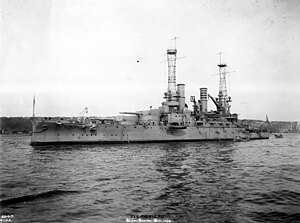South Carolina-class battleship

Michigan in the Hudson River for the 1912 Naval Review.
|
|
| Class overview | |
|---|---|
| Name: | South Carolina-class battleship |
| Builders: | |
| Operators: |
|
| Preceded by: | Mississippi class |
| Succeeded by: | Delaware class |
| In service: | 1910–1922 |
| Planned: | 2 |
| Completed: | 2 |
| Retired: | 2 |
| Preserved: | 0 |
| General characteristics | |
| Type: | Battleship |
| Displacement: | |
| Length: | |
| Beam: | 80 ft 3 in (24 m) |
| Draft: | 24 ft 6 in (7 m) |
| Installed power: |
|
| Propulsion: |
|
| Speed: | 18.5 kn (21 mph; 34 km/h) |
| Range: | 6,950 nmi (7,998 mi; 12,871 km) at 10 kn (12 mph; 19 km/h) |
| Complement: | 51 officers and 881 enlisted men |
| Armament: |
|
| Armor: | |
The South Carolina-class battleships, also known as the Michigan-class, were built during the first decade of the twentieth century for the United States Navy. Named South Carolina and Michigan, they were the first American dreadnoughts—powerful warships whose capabilities far outstripped those of the world's older battleships.
In the opening years of the twentieth century, the prevailing theory of naval combat was that battles would continue to be fought at relatively close range using many small, fast-firing guns. As such, each of the ships in the United States' previous battleship class (the Connecticut class) had many medium-sized weapons alongside four large guns. This paradigm, however, was soon to be subverted, as American naval theorists proposed that a ship mounting a homogeneous battery of large guns would be more effective in battle.
As their ideas began to enjoy wider acceptance, the US Congress authorized the country's Navy to construct two small 16,000 long tons (16,257 t) battleships. This displacement was roughly the same size as the Connecticut class and at least 2,000 long tons (2,032 t) smaller than the foreign standard. A solution was found in an ambitious design drawn up by Rear Admiral Washington L. Capps, the chief of the navy's Bureau of Construction and Repair, which featured heavy armament and relatively thick armor, both favored by naval theorists. However, in balancing the congressionally mandated limits to displacement and the inherent design trade-offs between armament, armor, and propulsion, the South Carolina class' speed was severely limited—an ultimately fatal disadvantage that severely limited their utility in a conflict.
With their superfiring main armament, press accounts billed South Carolina and Michigan, alongside the British HMS Dreadnought, as heralding a new epoch in warship design. Both, however, were soon surpassed by ever-larger and stronger super-dreadnoughts. The class' low top speed of about 18.5 kn (21 mph; 34 km/h), as compared to the 21 kn (24 mph; 39 km/h) standard of later American battleships, relegated them to serving with older, obsolete battleships during the First World War. Thereafter, both South Carolinas were scrapped with the signing of the Washington Naval Treaty.
...
Wikipedia
